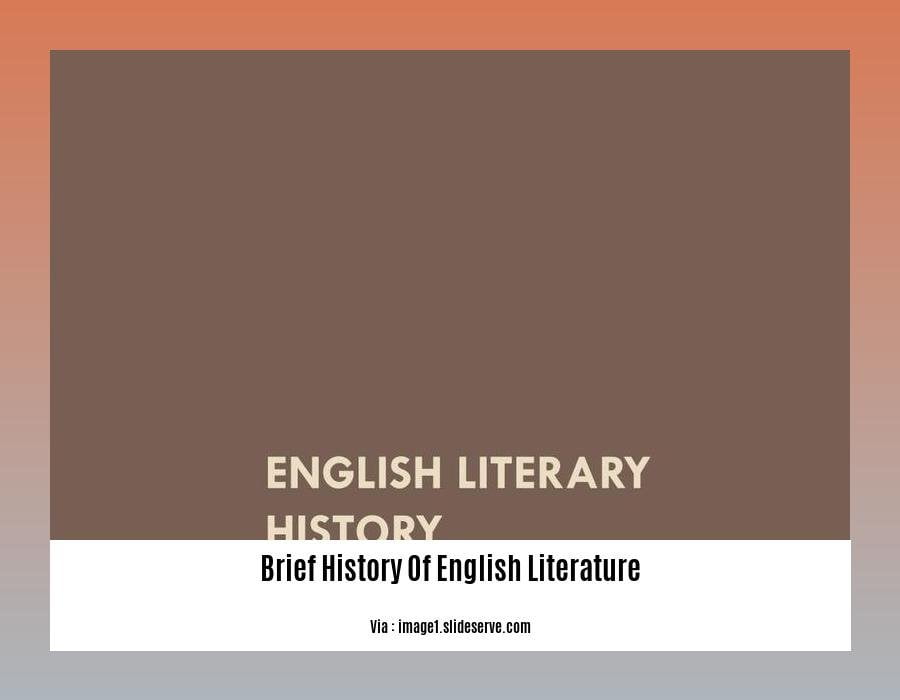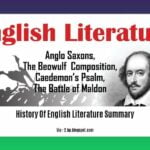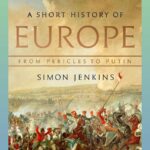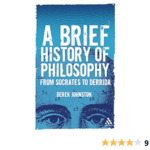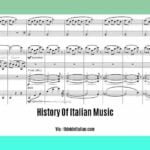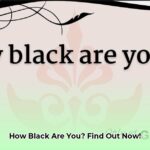Embark on a literary journey through the ages with “A Brief History of English Literature: Tracing Linguistic Evolution and Cultural Impact.” This exploration delves into the rich tapestry of English literature, tracing the evolution of the language from its Anglo-Saxon roots to the complexities of modern English. Prepare to uncover the profound impact of literary movements such as the Renaissance, Romanticism, and Modernism, as we unveil the enduring legacy of English literature in shaping cultural narratives and identities.
Key Takeaways:
- English literature encompasses written works in English from the British Isles, tracing back to the 7th century.
- The history of English literature can be divided into various periods, including the Anglo-Saxon, Middle English, Renaissance, Neoclassical, Romantic, Victorian, and Modern periods.
- The study of English literature involves analyzing texts, examining their historical and cultural contexts, and exploring their lasting impact on the literary landscape.
- Linguistic evolution plays a significant role in the history of English literature, from its Anglo-Saxon roots to the complexity of modern English.
A Brief History of English Literature
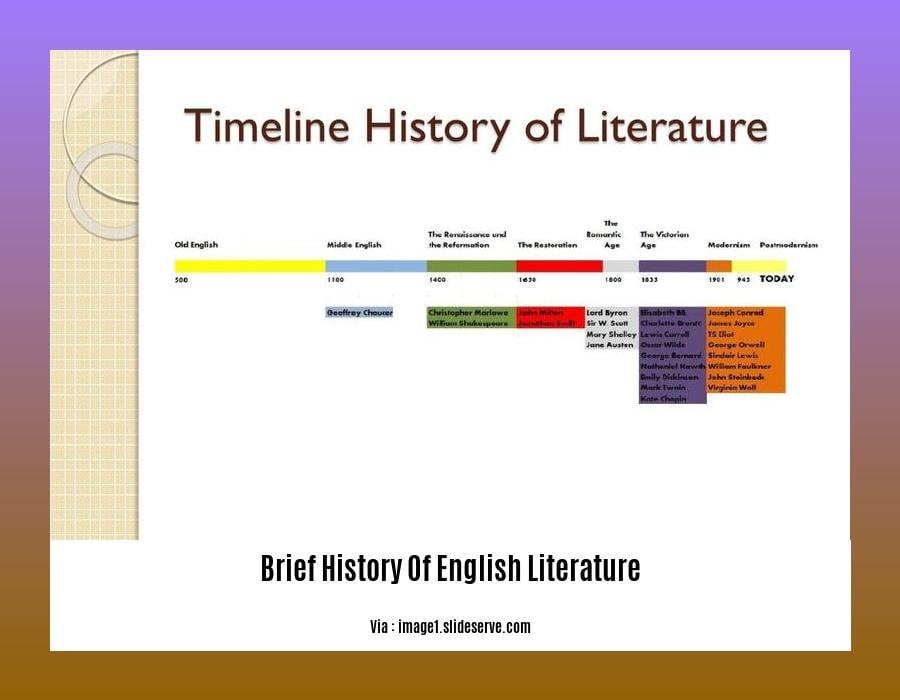
Tracing the captivating journey of English literature, we embark on an odyssey that spans centuries, showcasing the evolution of language, culture, and ideas.
Anglo-Saxon or Old English Period (450-1066):
- The foundation of English literature was laid during this period, heavily influenced by Germanic tribes who migrated to Britain.
Anglo-Norman or Middle English Period (1066-1500):
- The Norman invasion brought significant linguistic changes, blending Old English with French to form Middle English.
Renaissance Period (1500-1660):
- Literature flourished as England experienced a cultural and intellectual revival. This period marks the rise of iconic figures like William Shakespeare and John Milton.
Neoclassical Period (1660-1798):
- Writers sought inspiration from classical Greek and Roman literature, emphasizing rationality, order, and balance.
Romantic Period (1798-1837):
- Emotion, imagination, and individualism took center stage as Romantic poets, such as William Wordsworth and Samuel Taylor Coleridge, found their voice.
Victorian Period (1837-1901):
- A time of social, economic, and literary transformation, with authors like Charles Dickens and the Brontë sisters delving into social issues and psychological themes.
Modern Period (20th Century Literature):
- Modernist writers, including James Joyce and Virginia Woolf, experimented with narrative techniques, challenging traditional forms and pushing boundaries.
Through this brief history of English literature, we gain a glimpse into the dynamic and ever-evolving nature of this rich literary tradition, reflecting the shifts in society, culture, and the human experience itself.
Have you ever felt overwhelmed by the complexity of ballroom dance’s rich history? Dive into our comprehensive guide and unlock the fascinating journey of this beloved dance, from its humble beginnings to its modern-day grandeur. brief history of ballroom dance
Music’s captivating evolution through the ages has shaped cultures and ignited emotions. Embark on a melodic adventure with us, as we trace the roots of music from ancient rhythms to contemporary earworms. brief history of music
Discover the cradle of civilization and the vibrant spirit of Nigeria, as we delve into its captivating past. Get ready to be enthralled by tales of courage, resilience, and unwavering cultural identity. brief history of Nigeria
Renaissance literature: A Cultural and Intellectual Revival
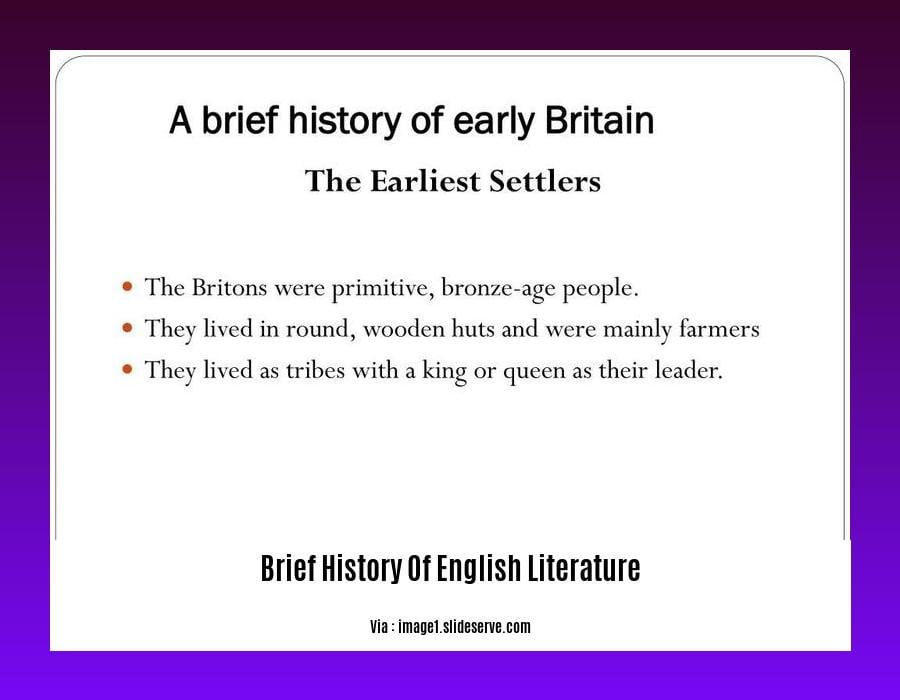
In the realm of English literature, the Renaissance period stands as a beacon of cultural and intellectual resurgence, a testament to the power of human creativity and expression. This era, spanning the late 15th to early 17th centuries, witnessed a remarkable flowering of literary endeavors, shaping the very foundation of our literary heritage.
Key Takeaways:
- Intellectual Rebirth: The Renaissance was a period of renewed interest in classical learning and culture, leading to a revival of ancient Greek and Roman ideals.
- Literary Luminaries: This era produced some of the most renowned literary figures in history, including William Shakespeare, Christopher Marlowe, Edmund Spenser, John Donne, and John Milton.
- Diverse Literary Forms: Poetry, drama, and prose flourished during the Renaissance, with sonnets, tragedies, comedies, and narrative poems gaining prominence.
- Humanist Perspective: Renaissance literature often explored themes of humanism, individualism, and the celebration of human potential.
- Cultural Fusion: The Renaissance witnessed a blending of classical and Christian influences, leading to a unique and diverse literary landscape.
A Return to the Classics
The Renaissance was characterized by a renewed fascination with classical Greek and Roman literature, art, and philosophy. Scholars and writers sought to emulate the eloquence and sophistication of the ancient masters, resulting in a revival of classical forms and styles. The works of Homer, Virgil, Ovid, and Cicero were eagerly studied and imitated, shaping the literary landscape of the period.
Luminaries of the Renaissance
The Renaissance produced a constellation of literary giants whose works continue to captivate readers to this day. William Shakespeare, the preeminent playwright of the era, crafted immortal tragedies like “Hamlet,” “Romeo and Juliet,” and “Macbeth,” exploring the complexities of the human condition. Christopher Marlowe, another theatrical luminary, penned the iconic tragedy “Doctor Faustus,” delving into themes of ambition and damnation.
A Tapestry of Literary Forms
During the Renaissance, a diverse range of literary forms flourished, each showcasing the versatility of the era’s writers. Poetry, in particular, reached new heights with the sonnet, a fourteen-line poem with a specific rhyme scheme. Sonnets were often used to express personal emotions and reflections, with poets such as Petrarch, Shakespeare, and Donne crafting enduring examples of this form.
Drama, too, underwent a transformation during the Renaissance. Playwrights like Shakespeare and Marlowe pushed the boundaries of theatrical convention, creating plays that explored complex themes and showcased the full spectrum of human experiences. Tragedies such as “Hamlet” and comedies like “A Midsummer Night’s Dream” continue to be performed and studied worldwide.
Prose also flourished during this period, with writers crafting historical chronicles, religious tracts, and works of fiction. The prose style of the Renaissance was characterized by its eloquence, wit, and attention to detail, providing a vivid portrait of the era’s intellectual and social landscape.
Humanism and Individualism
A defining characteristic of Renaissance literature was its emphasis on humanism, a philosophical movement that celebrated the inherent worth and potential of individuals. Writers of this period explored themes of self-discovery, personal growth, and the pursuit of knowledge. The works of humanists like Erasmus, More, and Montaigne questioned traditional authority and encouraged critical thinking, shaping the intellectual climate of the era.
A Cultural Tapestry
The Renaissance was a time of cultural fusion, as classical and Christian influences intertwined to create a unique and dynamic literary landscape. Writers drew inspiration from both traditions, resulting in works that reflected a rich tapestry of beliefs and ideas. The Bible, the works of Plato and Aristotle, and the writings of the Church Fathers were all sources of inspiration for Renaissance writers, contributing to the era’s intellectual and creative vitality.
Legacy of the Renaissance
The Renaissance left an indelible mark on the course of English literature. Its focus on humanism, individualism, and the celebration of human potential laid the foundation for modern literary thought. The works of Renaissance writers continue to be read, studied, and performed, serving as a testament to the enduring power of this remarkable period in literary history.
Citations:
- Renaissance Literature
- Characteristics of Renaissance Literature
English literature of the 18th century
The 18th century witnessed a surge of literary brilliance, painting a vivid portrait of an era in transformative change. Sweep away to an era marked by the rise of novels, the blossoming of neoclassical poetry, the emergence of the periodical essay, and the thrill of the Gothic macabre.
The Novel Takes Center Stage
The novel, a genre that had previously taken a back seat to poetry and drama, rose to prominence during this era. Authors such as Daniel Defoe, Samuel Richardson, and Henry Fielding revolutionized the art of storytelling, captivating readers with tales of adventure, romance, and social commentary. Defoe’s Robinson Crusoe (1719), a gripping account of a shipwrecked sailor’s battle for survival, epitomized the novel’s ability to transport readers to distant lands and extraordinary adventures.
Neoclassicism: A Symphony of Reason and Precision
In poetry, the 18th century heralded the dawn of neoclassicism, a literary movement characterized by a return to the classical ideals of order, reason, and clarity. Leading poets of this era, such as Alexander Pope and John Dryden, sought to emulate the harmonious structures and elegant language of ancient Greek and Roman literature. Their works, like Pope’s The Rape of the Lock (1712), showcased a mastery of form and a keen eye for detail, mirroring the era’s fascination with structure and balance.
Gothic Thrills: A Darker Side of Imagination
As the century progressed, a darker undercurrent emerged in English literature—the Gothic movement. This genre delved into themes of horror, the supernatural, and the macabre, captivating readers with tales of mystery, suspense, and the unknown. Horace Walpole’s The Castle of Otranto (1764) is widely regarded as the first Gothic novel, introducing elements that would become synonymous with the genre—haunted castles, ghostly apparitions, and a palpable sense of doom and gloom.
The Periodical Essay: Seeds of Enlightenment Thought
The 18th century also witnessed the emergence of the periodical essay, a literary form that provided a platform for authors to share their thoughts on a wide range of topics, from politics and philosophy to literature and culture. Joseph Addison and Richard Steele, two prominent figures in this movement, used their essays to promote Enlightenment ideals and engage in intellectual discourse, shaping public opinion and influencing literary trends.
Key Takeaways:
The 18th century was a period of significant literary transformation in England.
The rise of the novel, neoclassical poetry, the periodical essay, and Gothic literature marked this era.
Novels explored themes of adventure, romance, and social commentary, with authors like Defoe, Richardson, and Fielding leading the way.
Neoclassical poetry, exemplified by Pope and Dryden, emphasized order, reason, and clarity, mirroring the era’s fascination with structure and balance.
Gothic literature, epitomized by Walpole’s _Castle of Otranto_, delved into the supernatural and macabre, creating a new genre of thrilling darkness.
Periodical essays provided a platform for intellectual discourse, with Addison and Steele using them to promote Enlightenment ideals and influence public opinion.
This period’s literary legacy continues to inspire and influence contemporary literature, demonstrating the enduring power of 18th-century writers and their works.
Citations:
Litaid: 18th Century Literature (1700-1800)
Britannica: English Literature – Enlightenment, Satire, Novels
Modern and Contemporary Literature
In the realm of literary evolution, [modern and contemporary literature] stands as a testament to the ever-shifting landscape of human expression. This era, spanning the 20th and 21st centuries, is characterized by a kaleidoscope of styles, themes, and techniques that challenge traditional norms and push the boundaries of storytelling.
Key Takeaways:
- Modern and contemporary literature emerged as a response to the societal and cultural upheavals of the 20th century.
- Pioneering modernist writers like James Joyce, Virginia Woolf, and T.S. Eliot experimented with narrative techniques, stream of consciousness, and interior monologues, breaking free from conventional storytelling structures.
- Postmodern literature, a product of the late 20th century, deconstructed traditional notions of authorship, truth, and reality, embracing irony, fragmentation, and intertextuality.
- Contemporary literature continues to explore diverse themes, including identity, globalization, technology, and environmentalism, reflecting the complexities of the modern world.
The Modernist Movement (1900-1945)
The early 20th century witnessed the rise of modernism, a literary movement that sought to break away from the constraints of traditional Victorian literature. Modernist writers experimented with form and content, challenging accepted notions of narrative structure, character development, and language.
Postmodern Literature (1945-1990)
The postmodern movement emerged in the aftermath of World War II, characterized by a rejection of traditional notions of truth, reality, and objectivity. Postmodern writers embraced irony, fragmentation, and intertextuality, exploring the complexities of identity, language, and power.
Contemporary Literature (1990-Present)
Contemporary literature is a diverse and ever-evolving field that reflects the complexities of the modern world. Contemporary writers explore a wide range of themes, including globalization, technology, environmentalism, and identity, challenging traditional notions of storytelling and pushing the boundaries of literary expression.
Conclusion
[Modern and Contemporary literature] is a testament to the ever-evolving nature of human expression. From the experimental techniques of modernism to the deconstructive tendencies of postmodernism, and the diverse explorations of contemporary literature, this era has witnessed a remarkable transformation in the way we tell and experience stories.
Sources:
- Modernism (literature)
- Postmodern literature
FAQ
Q1: What are the major periods in the history of English literature?
A1: The major periods in English literature include the Anglo-Saxon or Old English Period (450-1066), the Anglo-Norman or Middle English period (1066-1500), the Renaissance Period (1500-1660), the Neoclassical Period (1660-1798), the Romantic Period (1798-1837), the Victorian Period (1837-1901), and the Modern Period (20th Century Literature).
Q2: Who are some of the literary giants associated with the English Renaissance?
A2: Some of the literary giants associated with the English Renaissance include William Shakespeare, Christopher Marlowe, Edmund Spenser, John Donne, and John Milton.
Q3: What was the impact of the Age of Enlightenment on 18th-century English literature?
A3: The Age of Enlightenment had a profound impact on 18th-century English literature, leading to the rise of the novel, the development of neoclassical poetry, the emergence of the periodical essay, and the exploration of Gothic themes.
Q4: What were the characteristics of neoclassical poetry?
A4: Neoclassical poetry was characterized by its rational order, clarity, precision, and elegance, often using heroic couplets as its form.
Q5: What was the significance of Old English literature?
A5: Old English literature holds significance as it represents the earliest form of written English and includes notable works such as the epic poem Beowulf, which provides valuable insights into Anglo-Saxon culture and mythology.
- Amazing March Fun Facts: Unveiling History & Celebrations - April 15, 2025
- Master how to write height: A complete guide - April 15, 2025
- How High Are Your Standards Test: Find Your Perfect Match Now - April 15, 2025
